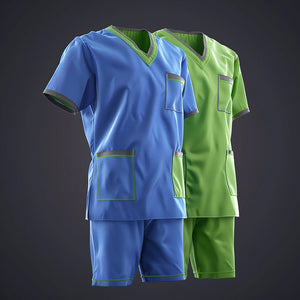Choosing the right color of scrubs is a decision that goes beyond mere aesthetics. The color of your scrubs can influence the atmosphere of your workplace, affect your patients' perceptions, and even impact your own mood and performance. In this comprehensive guide, we'll delve into the importance of scrub colors, their psychological effects on patients, the symbolism behind each color, and the most common colors worn by medical professionals. By understanding these factors, you can make an informed decision about which scrub color is best suited for your role in healthcare.

Why the Color of Scrubs You Wear is Important
The significance of scrub colors extends beyond personal preference. The color of your scrubs can communicate a lot about your role, professionalism, and the environment you aim to create. Here are a few reasons why the color of your scrubs is important:
- Professional Image: The color of your scrubs can affect how patients and colleagues perceive you. Certain colors are traditionally associated with specific roles in healthcare, such as surgeons often wearing green or blue scrubs. Choosing the right color can help you fit into your professional environment and be recognized for your role.
- Psychological Impact: Colors can influence emotions and behaviors. For instance, blue and green are known for their calming effects, making them popular choices in high-stress environments like operating rooms and emergency departments. On the other hand, bright colors like red or orange might be more stimulating or alarming.
- Branding and Uniformity: Many healthcare facilities use color-coded scrubs to distinguish between different departments or job functions. This helps in creating a cohesive look and aids in quick identification of staff roles by patients and other staff members.
- Personal Comfort and Mood: The color of your scrubs can also affect your own mood and comfort level. Wearing a color that you feel good in can boost your confidence and overall job satisfaction.
Does the Color of Your Scrubs Affect Your Patients?

Absolutely, the color of your scrubs can significantly impact your patients' experiences. Patients often feel more comfortable and reassured when medical professionals wear colors that are associated with calmness and trust. Here are some ways scrub colors can affect patients:
- Reducing Anxiety: Colors like blue and green are often associated with tranquility and healing. These colors can help reduce patients' anxiety, making them feel more at ease during their visits.
- Building Trust: Certain colors can help build trust between patients and healthcare providers. Blue, for example, is often associated with professionalism and reliability, which can enhance patient confidence in their caregivers.
- Eliciting Emotions: Bright colors like red or yellow can elicit strong emotional responses. While these colors can be energizing, they might not be suitable for all medical environments. For instance, red might be too stimulating or alarming for some patients, especially in a high-stress situation.
- Creating a Healing Environment: Soft, pastel colors such as light blue or lavender can create a soothing environment that promotes healing and comfort. These colors are often used in pediatric wards or women's health clinics to create a warm and nurturing atmosphere.
What Each Color Represents In Healthcare
Each color of scrubs carries specific connotations and is often chosen for particular reasons in healthcare settings. Understanding these associations can help you choose the most appropriate color for your role and environment.
- Blue Scrubs: Blue is the most popular color in medical settings due to its association with calmness and serenity. It's believed to reduce eye strain and create a sense of trust and professionalism. Blue scrubs are often worn by nurses, doctors, and other healthcare professionals.
- Green Scrubs: Green is considered the color of healing and renewal. It is easy on the eyes and helps surgeons reduce glare from bright lights in the operating room. Green is also associated with nature and tranquility, making it a popular choice for surgical teams and emergency departments.
- White Scrubs: Traditionally, white scrubs are worn by doctors and laboratory personnel. White represents purity, cleanliness, and sterility. However, it can be difficult to maintain and may cause anxiety in some patients due to its association with sterility and hospitals.
- Red Scrubs: Red is a powerful color that can evoke strong emotions. It's often used to indicate emergency or surgical personnel due to its visibility and association with urgency. However, because it can be perceived as intense or alarming, it is used sparingly in clinical settings.
- Black Scrubs: Black conveys authority and sophistication. It is increasingly popular in non-surgical settings for its modern and professional appearance. Black scrubs can also create a slimming effect and hide stains well, making them a practical choice for many healthcare professionals.
- Purple Scrubs: Purple is often associated with luxury, wisdom, and creativity. It is sometimes worn by senior staff or specialists to denote expertise and leadership. Purple can create a sense of calm and is often used in settings where a reassuring presence is needed.
- Pink Scrubs: Pink is a compassionate and nurturing color, often worn in pediatric or women’s health departments. It is associated with warmth and care, making it a great choice for environments where comfort and empathy are paramount.
Common Colors Worn By Medical Professionals
While personal preference and departmental guidelines play significant roles, certain colors are more commonly seen in specific healthcare settings. Here are some of the most common scrub colors and their typical uses:
- Navy Blue Scrubs: Commonly worn by nurses and support staff, navy blue is a versatile color that conveys professionalism and competence. It is suitable for various healthcare environments, including hospitals, clinics, and long-term care facilities.
- Hunter Green Scrubs: Popular among surgeons and operating room staff, hunter green is known for its calming and reassuring qualities. This color helps reduce glare from bright lights and is often used in surgical settings to create a soothing environment.
- Ceil Blue Scrubs: Frequently seen in various healthcare settings, ceil blue is a soft, light blue that promotes a sense of tranquility and trust. It is a popular choice for nurses, doctors, and other healthcare professionals who work in high-stress environments.
- Black Scrubs: Increasingly chosen by administrative staff and certain medical professionals, black scrubs offer a sleek and modern look. They are often worn in non-surgical settings and are favored for their ability to hide stains and create a professional appearance.
- Purple Scrubs: Worn by specialists or senior medical staff, purple scrubs denote expertise and leadership. This color is often associated with wisdom and creativity, making it a popular choice for those in positions of authority or in specialized fields.
- Pink Scrubs: Preferred in pediatric and maternity wards, pink scrubs have a warm and comforting effect on patients. They are often associated with care and compassion, making them ideal for environments where emotional support is crucial.
Source: Let's TEACH
Conclusion
Choosing the right color of scrubs is more than just a fashion statement; it’s an essential part of creating a positive healthcare environment. By understanding the psychological impacts of different colors, you can enhance your professional image, improve patient interactions, and contribute to a more harmonious workplace.
When selecting your scrubs, consider not only your personal preference but also the message you want to convey to your patients and colleagues. Whether you opt for the calming effect of blue, the healing aura of green, or the authoritative presence of black, your choice of scrub color can make a significant difference in your daily professional life.
Remember to take into account the specific requirements and culture of your workplace, as well as any departmental guidelines regarding scrub colors. By doing so, you can ensure that your choice of scrubs supports your role, enhances patient care, and fosters a positive and professional healthcare environment.











